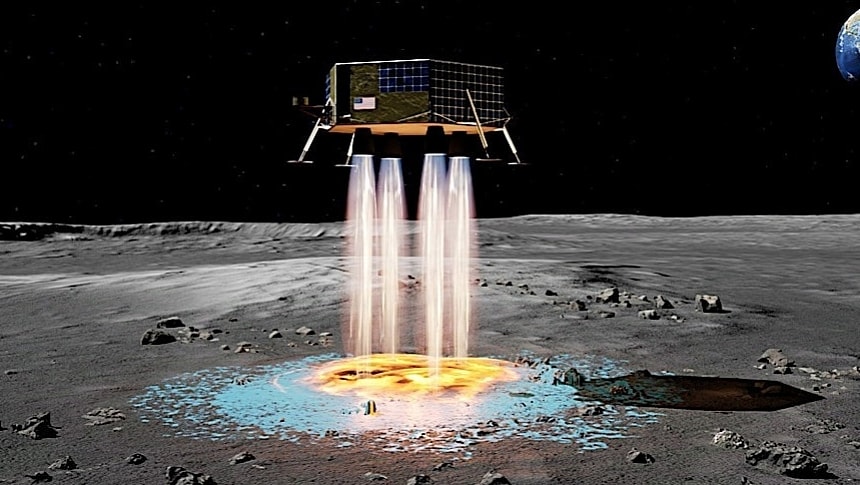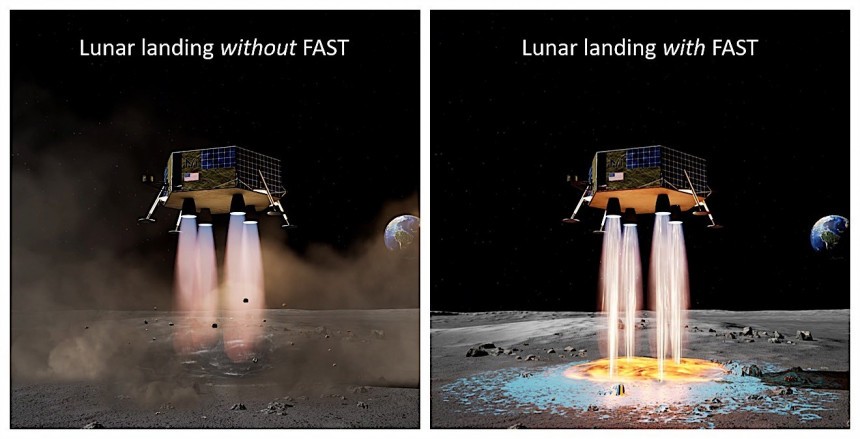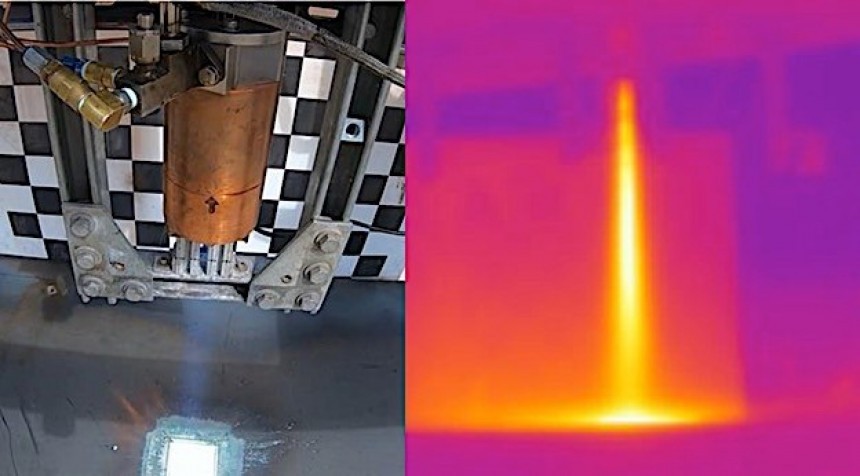Landing on the Moon is something humanity has done before and, hopefully, will do again with relative ease once the Artemis program really gets going. At least that’s how it looks from the sidelines, because if you really dig into the matter you’ll be astonished at how many problems need to be overcome for a successful trip there to happen.
One of the often-overlooked problems with Moon landings is dust. As you know, the surface of the satellite is covered in a very abrasive powder that has a tendency to stick to whatever surface it comes in contact with.
We call that powder regolith, and when not disturbed it is harmless. The astronauts of the Apollo missions, however, found out the hard way that the stuff can be a real hassle during long walks on the surface. And the Artemis peeps will have an even harder time, because this time we’re going up there to stay, and we’ll do so in much more potent spaceships.
What do spaceships have to do with the dust on the Moon’s surface, you ask? Just like it happens here on Earth when, for instance, a helicopter lifts off or lands making a mess of its surroundings, a rocket engine landing or departing the Moon will throw up regolith.
Given the flimsy atmosphere up there, and the fact that gravity is weaker than on Earth, the stuff will literally be thrown everywhere. That may not be an issue in itself, because there are no human structures (yet) near the landing sites, but I remind you regolith has a tendency to stick to pretty much everything and it could significantly damage the lander and its sensitive instruments.
There are several organizations currently working on a solution to prevent regolith from being thrown up during landing (or, at least, reduce the quantity). Most of these organizations are private, and their ideas range from the rocket melting the regolith beneath as it descends, effectively turning the surface into a self-made landing pad, to depositing ceramic particles right from the engine exhaust to solidify the surface.
We’ve talked about these ideas a while back, but we heard no more updates since. What we were updated on last week is the status of a competition called Human Lander Challenge (HuLC).
HuLC was announced in March 2023 as a competition meant for undergraduate and graduate college students. Its goal was to find “ways to manage or prevent the cloud of dust a spacecraft stirs up when using rocket engines to land on unprepared surfaces like the Moon.”
More than a year after the competition began NASA announced the winners. There are five teams in all, picked from a pool of 12 university teams in March 2024, and awarded rather small sums of money for their projects in an event held at the end of June in Huntsville, Alabama.
Two teams were handed the excellence in systems engineering award for their work. The first is a crew from the Texas A&M University, who proposed something called the Synthetic Orbital Landing Area for Crater Elimination (SOLACE).
The thing is technically a sort of self-propelled landing pad that can be lowered to the surface and turn into a fixed piece of hardware on which landers can touch down.
The second team project to be recognized is the one from the Embry-Riddle Aeronautical University, Prescott, and it’s called Plume Additive for Reducing Surface Ejecta and Cratering (PARSEC). What this thing does, in essence, is inject granular additives into the rocket plume that should conglomerate regolith particles during landing and effectively prevent them from flying all over the place.
The third place and a $3,000 award in the main competition went to the University of Colorado Boulder team for a project titled Lunar Surface Assessment Tool (LSAT). This thing is not actually a solution to the problem put forward by NASA, but a way to perform dust dynamics simulation in a bid to get a better understanding of the landing site conditions.
The runner-up and winner of a $5,000 award in the HuLC challenge was the HINDER, or Holistic Integration of Navigational Dynamics for Erosion Reduction, put up by the team from the University of Illinois, Urbana-Champaign.
HINDER is a collection of tools, including radars and simulators, meant to inform mission control on the best site (read the most regolith-free) to put down a spacecraft.
The winner of the NASA competition and a $10,000 prize is the University of Michigan team with something called the Algorithm for Robust Characterization of Lunar Surface Imaging for Ground Hazards and Trajectory (ARC-LIGHT).
This idea does not take the regolith out of the equation either, but it relies on camera and lidar sensor techniques, some of them borrowed from autonomous vehicles, to improve landing safety and precision.
NASA says all of the ideas listed above have the potential to be ready for use in up to five years, just in time for the true start of the Artemis exploration program. The agency didn’t say, however, if it will actually go for one of these solutions.
autoevolution will have a closer look at the merits and downsides of each idea in the days ahead, and we will come back with separate stories on each of them.
We call that powder regolith, and when not disturbed it is harmless. The astronauts of the Apollo missions, however, found out the hard way that the stuff can be a real hassle during long walks on the surface. And the Artemis peeps will have an even harder time, because this time we’re going up there to stay, and we’ll do so in much more potent spaceships.
What do spaceships have to do with the dust on the Moon’s surface, you ask? Just like it happens here on Earth when, for instance, a helicopter lifts off or lands making a mess of its surroundings, a rocket engine landing or departing the Moon will throw up regolith.
Given the flimsy atmosphere up there, and the fact that gravity is weaker than on Earth, the stuff will literally be thrown everywhere. That may not be an issue in itself, because there are no human structures (yet) near the landing sites, but I remind you regolith has a tendency to stick to pretty much everything and it could significantly damage the lander and its sensitive instruments.
We’ve talked about these ideas a while back, but we heard no more updates since. What we were updated on last week is the status of a competition called Human Lander Challenge (HuLC).
HuLC was announced in March 2023 as a competition meant for undergraduate and graduate college students. Its goal was to find “ways to manage or prevent the cloud of dust a spacecraft stirs up when using rocket engines to land on unprepared surfaces like the Moon.”
More than a year after the competition began NASA announced the winners. There are five teams in all, picked from a pool of 12 university teams in March 2024, and awarded rather small sums of money for their projects in an event held at the end of June in Huntsville, Alabama.
Two teams were handed the excellence in systems engineering award for their work. The first is a crew from the Texas A&M University, who proposed something called the Synthetic Orbital Landing Area for Crater Elimination (SOLACE).
The thing is technically a sort of self-propelled landing pad that can be lowered to the surface and turn into a fixed piece of hardware on which landers can touch down.
The third place and a $3,000 award in the main competition went to the University of Colorado Boulder team for a project titled Lunar Surface Assessment Tool (LSAT). This thing is not actually a solution to the problem put forward by NASA, but a way to perform dust dynamics simulation in a bid to get a better understanding of the landing site conditions.
The runner-up and winner of a $5,000 award in the HuLC challenge was the HINDER, or Holistic Integration of Navigational Dynamics for Erosion Reduction, put up by the team from the University of Illinois, Urbana-Champaign.
HINDER is a collection of tools, including radars and simulators, meant to inform mission control on the best site (read the most regolith-free) to put down a spacecraft.
The winner of the NASA competition and a $10,000 prize is the University of Michigan team with something called the Algorithm for Robust Characterization of Lunar Surface Imaging for Ground Hazards and Trajectory (ARC-LIGHT).
This idea does not take the regolith out of the equation either, but it relies on camera and lidar sensor techniques, some of them borrowed from autonomous vehicles, to improve landing safety and precision.
NASA says all of the ideas listed above have the potential to be ready for use in up to five years, just in time for the true start of the Artemis exploration program. The agency didn’t say, however, if it will actually go for one of these solutions.
autoevolution will have a closer look at the merits and downsides of each idea in the days ahead, and we will come back with separate stories on each of them.








